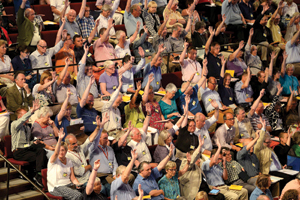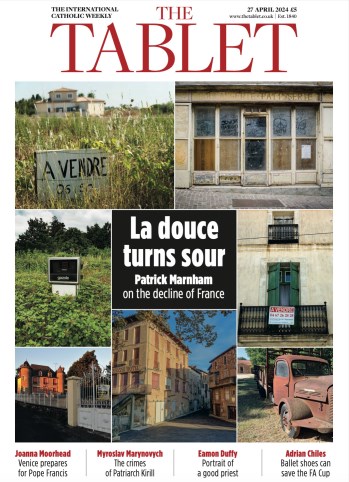The Church of England’s synod this week voted to allow women to be ordained as bishops. But what will it mean for Anglicans’ relationship with Rome?
For those who have long wanted to see women ordained as bishops in the Church of England – who have seen all manner of compromises on the subject since women were first ordained in the mid 1990s – the words of the Archbishop of York, Dr John Sentamu, when the vote to consecrate them to the episcopacy succeeded, may have been baffling. It was right, he said, that the previous attempt had failed.
He had a point. The 2012 legislation, which tried to provide for every eventuality of dispute, was too complex and tortuous. Although he and others were quick to pay tribute to Lord (Rowan) Williams for the decade of hard work he put in as Archbishop of Canterbury in attempting to reconcile the Church of England’s warring factions, the new legislation that succeeded this week represents the new style of leadership under Justin Welby. For the first time since it came into being, perhaps, the Church under Archbishop Welby has found a way to be true to its ecclesiological commitment to being “episcopally led and synodically governed”.
An example of this came in the way he dextrously fielded the inevitable question about the impact of this vote on relations with Rome. Challenged about the impact on ecumenism, the archbishop said: “There are areas where this will have improved very significantly our ecumenical relationships, with many of the Lutheran Churches of Northern Europe, with Methodists, with many of the Pentecostal Churches, black Pentecostal Churches, there’s a huge, long list … They will feel we have taken a step towards catching up.”
lesiological problems of women’s ministry do seem insurmountable.
To understand why, it is worth going back to a pivotal moment at the 2008 Lambeth Conference gathering of bishops from throughout the world when they were addressed by Cardinal Walter Kasper, the then president of the Pontifical Council for Promoting Christian Unity. He was asked to speak to the title: “Roman Catholic Reflections on the Anglican Communion”.
Many of the bishops at Rowan Williams’ indaba-styled gathering were used to encountering this genial, seemingly pro-Anglican Catholic bishop on the globetrotting ecumenical conference circuit. With women bishops by that time well advanced on the Church of England agenda, they were anticipating friendly words from Rome. The discomfort was tangible when Kasper remained true to the teachings of his own Church. His words even hinted at what would become the ordinariate.
In the stuffy marquee where we sat, squeezed up against each other in tented, temporary unity, bishops shifted uneasily on their seats as he addressed the “series of ecclesiological issues arising from the current situation in the Anglican Communion”. Regarding the ordination of women to the priesthood and episcopate, the Catholic Church’s teaching was clear, he said, citing correspondence between Pope Paul VI and Pope John Paul II with successive Archbishops of Canterbury: “I declare that the Church has no authority whatsoever to confer priestly ordination on women and that this judgement is to be definitively held by all the Church’s faithful.”
This was not what the Anglicans wanted to hear. But there was more. For him, the decision to ordain women implied a turning away from the common position of all Churches of the first millennium. He was clear about the implications. “While our dialogue has led to significant agreement on the understanding of ministry, the ordination of women to the episcopate effectively and definitively blocks a possible recognition of Anglican orders by the Catholic Church.”
More than a century after Leo XIII’s encyclical Apostolicae Curae, on the nullity of Anglican orders, was published, Anglicans, especially from the Catholic tradition, still long for official recognition of their orders from Rome. Had Kasper been able to give a different type of address that day, it is possible the Church of England would have had less of a struggle to get where it did at the General Synod this week. It made sense, therefore, for Archbishop Welby to look to the Anglicans’ Protestant brothers and sisters when talking about future ecumenism. He had discussed women’s ordination at length with Pope Francis and it was clear from the archbishop’s words that, in spite of the Western view of the present Pope as more liberal than his predecessors, the stance in Rome on women’s ordination remains unchanged, even if the tone of the dialogue has improved.
Until now, it has been pressure from the top that has kept the stained-glass ceiling in place in the Church of England. It was not long after Pope Leo XIII’s 1896 encyclical that women’s ordination began to be talked about in the UK as part of the suffragette movement. In the US, the suffragette Antoinette Brown Blackwell had already become the first woman minister of a Protestant denomination, ordained into the Congregational Church in 1853 later becoming a Unitarian. In the UK, the Anglican preacher and suffragist Maude Royden wrote in 1915 that “there was nothing in the priesthood any more than in church councils that would in the future justify the exclusion of women”. An archbishop’s mission council a year later endorsed her proposal for bishops to endorse “the best ways of using the services and receiving the message of women speakers, whether in church or elsewhere” but permission for women to preach was later withdrawn after protests.
And that was pretty much how it continued for the next century, until 14 July 2014, ironically the anniversary of John Keble’s famous Assize sermon in 1833 which represented the beginning of the Oxford Movement and the Anglo-Catholic revival in the Church of England. Every step forward seemed to be followed by one or two steps back.
So in 1920 women’s ordination was put on the agenda of the Lambeth Conference and the vote was lost, and again in 1930. A 1935 commission recommended against it. In 1944 Bishop Ronald Hall of Hong Kong broke the Anglican tradition of a male-only priesthood by ordaining a Chinese deaconess on the neutral island of Macao, Florence Li Tim-Oi, to celebrate the sacrament. After the war she was forced to revert to being a deaconess, and if anything, resistance to women’s ordination at successive Lambeth conferences became stronger.
Not until 1971 did the Anglican Consultative Council, the most senior advisory body in the Anglican Communion, chaired by the Archbishop of Canterbury, Dr Michael Ramsey, advise bishops that, with the approval of their province, they could ordain women to the priesthood. In 1974, as a result, 11 women in America were “irregularly” ordained by three US bishops, and the following year, the General Synod voted that there is “no fundamental objection to the ordination of women to the priesthood”. In 1976 the Episcopal Church in the US became the first to vote formally to ordain women and the previous irregular ordinations were also accepted. In 1978 an attempt in synod in England to “bring forward legislation to remove the barriers to the ordination of women to the priesthood and their consecration to the episcopate” failed after six and a half hours of debate, prompting the foundation of the Movement for the Ordination of Women in 1979. The synod took its first tentative steps a few years later, voting to ordain women deacons.
This week’s vote came after earlier legislation was defeated narrowly in November 2012. To date, 37 women have been consecrated bishop in the Anglican Communion and of these, 28 are currently serving. They include Ireland’s Pat Storey, consecrated Bishop of Meath and Kildare last November.
The new legislation is simpler and based on Christian understandings of trust. Crucially, it includes a commitment for diocesan bishops to abide by five guiding principles, to take proper care of and provide oversight for dissenters, with recourse to an independent reviewer, or ombudsman, to resolve disputes. This was a concept introduced to steering-group discussions by Dr Philip Giddings, the leading conservative Evangelical, who specialised in politics and the work of the Parliamentary Ombudsman. His speech to synod, where he committed himself to vote in favour, coming as it did early in the debate, was influential in securing the result.
Even the Catholic group seemed happy, relatively speaking, with the result. Canon Simon Killwick, the chairman, remained deeply concerned for the wider unity of the whole Church but “pleased that the spirit of reconciliation continued to be displayed during the debate”. Archbishop Bernard Longley, chairman of dialogue and unity for the Catholic bishops, reiterated the goal of full ecclesial communion and acknowledged that the decision “sadly places a further obstacle on the path to this unity between us”. He affirmed the progress made in recent decades.
Whatever the theological and ecclesiological disagreements that remain, for the established Church to have once again rejected women bishops could well have spelled disaster for Christian mission in Britain. The signals from Rome and Canterbury give every appearance of grace in action – surely a prophecy of interesting times to come.
Ruth Gledhill is a former religious affairs correspondent of The Times, who has covered the General Synod for more than 25 years.





 Loading ...
Loading ...
What do you think?
You can post as a subscriber user...
User Comments (0)